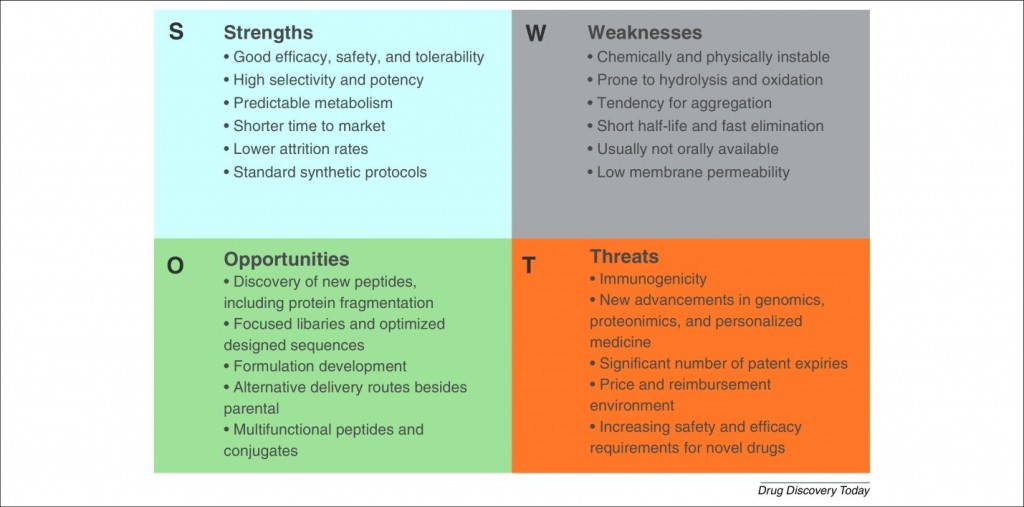Peptides are an interesting bet for pharmaceutical companies. Their role as mediators of key biological functions and their unique intrinsic properties make them particularly attractive therapeutic agents: peptides show high biological activity associated with low toxicity and high specificity. Even the big pharmaceutical companies, traditionally focused on small molecules, are increasingly considering peptides in their pipelines. More than 60 peptide drugs have reached the market for the benefit of patients and several hundreds of novel therapeutic peptides are in preclinical and clinical development. The key contributor to this success is the potent and specific, yet safe, mode of action of peptides.
What are peptides
Peptides are naturally occurring biological molecules and short chains of amino acid monomers linked by peptide (amide) bonds. Peptides are found in all living organisms and play a key role in all manner of biological activity. When a molecule consists of 2-50 amino acids it is called a peptide, whereas a larger chain of > 50 amino acids generally is referred to as a protein.
Major classification of peptides?
More than 7000 naturally occurring peptides have been identified, and these often have crucial roles in human physiology, including actions as hormones, neurotransmitters, growth factors, ion channel ligands, or anti-infective.
While peptides are involved in a number of ways in the body’s chemistry, they can best be classified by their functions.
Hormones
- Hormones are types of peptides that carry signals between glands and cells. Insulin, human growth hormone, bradykinins, gastrins and oxytocins are peptides that are common hormones.
Neuropeptides
- Neuropeptides are produced in the brain and are found in neural tissues. These peptides function as an extension of the neurosystem throughout the body acting as signals and regulators in processes that are triggered from places in the brain. Endorphins are common forms of neuropeptides.
Alkaloids
- Alkaloids are peptides that are commonly used in the development of defense mechanisms in types of fungi, plants and small animals such as shellfish. Ergotamine, pandamine and dynorphin are types of alkaloid peptides.
Antibiotics
- Antibiotics are peptides that stop the growth of microorganisms in the body. They are frequently used in medicine to kill disease-causing bacteria.
Transporters
- All cells have a protective membrane that prevents most substances from easily passing into the cell. According to the book “Advanced Nutrition and Human Metabolism,” some peptides act as transporters that selectively allow certain substances to pass into the cell through the cell membrane. For example, glucose transporters are necessary for glucose to travel from the blood into muscle or other cells to be used for energy. Similarly, cellular waste products can exit the cell through certain peptide transporters.
Enzymes
- Enzymes are biologic catalysts that speed up metabolic reactions. According to “Principles of Biochemistry,” most enzymes are peptides. Hundreds of enzymes are located throughout the body to speed up reactions involved in many processes. These processes include the digestion of food, production of energy and synthesis of cellular components.
What are the functions of peptides in our body?
In the human body, peptides are found in every cell and tissue and perform a wide range of essential functions. Peptides often act as hormones and thus constitute biologic messengers carrying information from one tissue through the blood to another.
Peptides have the strong ability to heal damaged muscle fibers rapidly allowing the user to return quickly to their sport. When peptide chains reach a long length, they form proteins that, in turn, are the building blocks for parts of the human body and animal bodies. Keratin, a protein, is a part of hair and nails in humans and makes up the claws, horns, feathers, scales and hooves of animals. Collagen, another protein made from peptides, is a part of tendons and ligaments, as well as tooth enamel and bones.
Peptides and medicine:
Peptides represent an excellent starting point for the design of novel therapeutics and their specificity has been seen to translate into excellent safety, tolerability, and efficacy profiles in humans. Naturally occurring peptides are often not directly suitable for use as convenient therapeutics because they have intrinsic weaknesses, including poor chemical and physical stability, and a short circulating plasma half-life. These aspects must be addressed for their use as medicines. The main disease areas currently driving the therapeutic use of peptide drugs are metabolic diseases and oncology. The former can be characterized by the epidemic growth in both obesity and diabetes –T2 , the latter by a rising mortality and need for chemotherapy replacement, as well as cancer supportive care.
We believe that the future development of peptide drugs will continue to build upon the strengths of naturally occurring peptides, with the application of traditional rational design to improve their weaknesses, such as their chemical and physical properties.

